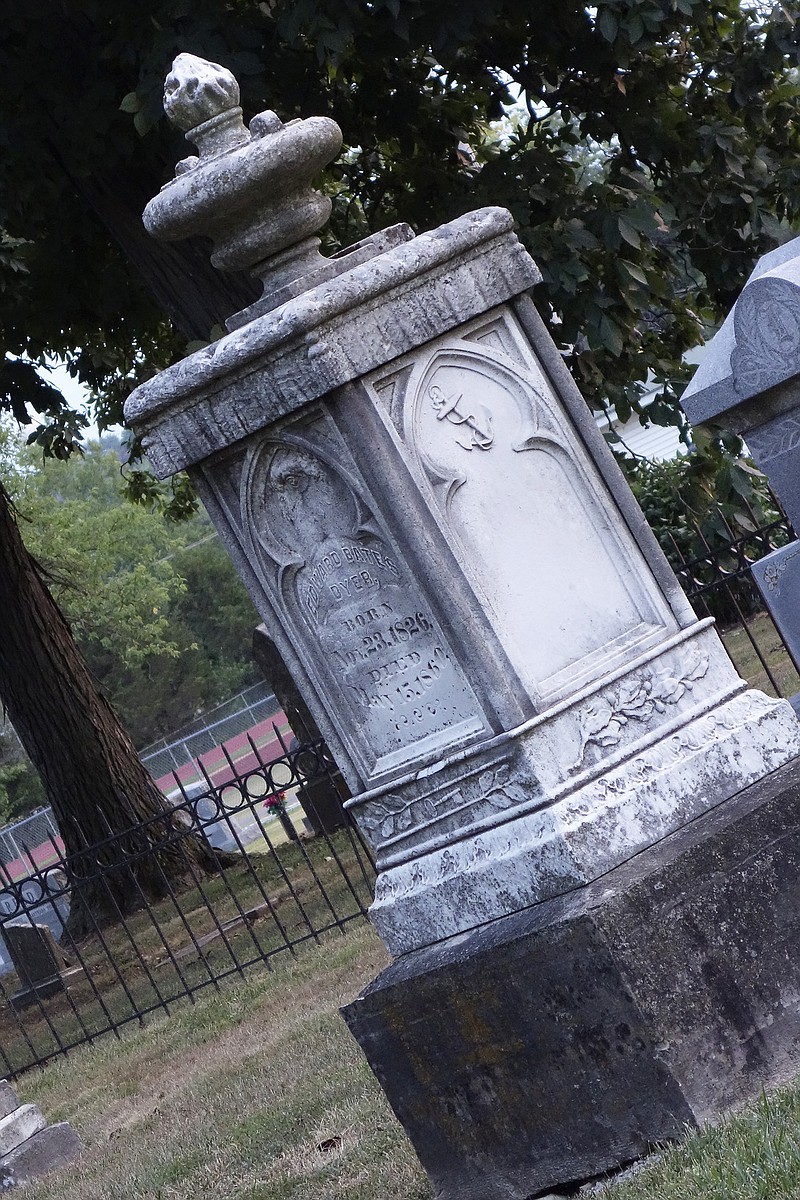A rather large tombstone decorated with anchors, two leafed branches and a single key states Edward Bates Dyer was born Nov. 23, 1826, and died May 15, 1860.
What appears to be a large eye stares out from the granite above his name. His grave lies within Hillcrest Cemetery in Fulton, on land donated by his widowed mom.
Find A Grave research states Dyer was born in Callaway County and died at age 33. He was the son of Samuel Dyer and Martha Tabb (Watkins) Dyer, and is listed on the 1860 census.
Eight siblings are listed for Dyer: Thomas, Mary Jane, Martha, Samuel, Virginia, Eliza, Susan and baby Hazeltine.
Samuel Dyer Junior, his father, was born Dec. 16, 1790, in Albemarle County, Virginia, to parents Samuel Dyer (senior) and Celia Bickley. In 1823, Sam Jr. came to Callaway County with his family and was known as the second merchant of Fulton - he built a farm, a mill and some think a store.
Sam Jr. was said to have prospered in his new home, and the town was shocked when he died on March 7, 1834, at age 43. Hazeltine, a son, was born after his death and lived just one year, seven months.
After Sam Jr.'s death, his wife, Martha, donated land to the city of Fulton for the purpose of a cemetery. His marker incorrectly states the month of his death as May. After falling ill in January 1834, he signed his will on March 5 and died on the seventh, and the will was entered into probate that March 29.
Martha Tabb Watkins Dyer kept a journal from Jan. 1, 1823, to Dec. 31, 1839. Her diary is housed in the Alderman Library in Charlottesville, Virginia, but pieces exist at the Kingdom of Callaway Historical Society in Fulton.
Martha was born Sept. 20, 1795, in Goochland County, Virginia, and died in Fulton at age 66 on July 28, 1862. She also is buried in Hillcrest Cemetery.
Martha was described in a family record as an "energetic person, good organizer, and a clever housewife." Her journal starts in early 1823 while making trip preparations from the Dyer family home, "Plain Dealing" in Albermarle County, Virginia.
She describes making a wagon sheet and sewing on a tent, making travel clothing for her (then) four children and visiting the dentist.
The trip itself started off by horseback and wagon, overland. The pioneers journeyed to the Blue Ridge by May 9, 1823, and through Waynesborough, Staunton, over Cow Pasture river in western Virginia, and then on to Warm Springs on May 11 (in the George Washington and Jefferson National Forest ,presently).
The assembly had arranged for a boat on Calvin Creek, a dirty and unwelcoming vessel, which took them to the Kanawha River, the Ohio River, and finally to Point Pleasant, West Virginia, on June 1. The trek continued to Louisville, Kentucky, then on a short overland haul to a steam packet. That final vessel finally brought the group to St. Louis by June 14, 1823.
Friends already living in Callaway County met them there and helped them to their new land in Callaway County in late June. They had to create a working farm and home from scratch on this property, just northwest of Calwood by a creek now named Dyers Run.
It was noted Sam Jr. had come to Missouri in 1819 to get land, but it's unclear if this is the same land.
Martha talked about creating the farm, the house and a subsequent mill, construction of which began the following May. On Jan. 7, 1825, she notes she saw a wolf. One month she mentioned temperatures well below zero, and later, deathly hot weather.
Samuel Dyer Junior became sick and suffered a violent seizure, noted in Martha's diary on Jan. 11, 1834. Two diagnosis were made: St. Anthony's Fire (an acute infection with a skin rash), and erysipelas, another name for a bacterial skin infection that is a form of cellulitis. He was treated by doctors Curd, Mills and Morse, but died March 7, 1834, leaving Martha alone with her babies and their dreams.
On Nov. 22, 1834, she notes having to sell her livestock.
Things got better and Martha grew the family fortunes. Other journal entries talk about church construction, help at child birthings, illnesses and funerals, elections and marriages. Family visited from far away or lived nearby. Martha attempted to donate 8 acres of land to the state for the University of Missouri, but then notes "we were cheated out of the university."
She went to sugar camp and created lists of household duties, planting and farm work, foods on the table, and medications used. According to Find A Grave, the Dyer children married well and raised families who impacted the world in a positive manner.
There is some confusion between files on Rootsweb Worldconnect about Samuel Dyer Senior, born Oct. 8, 1751, in Pittsylvania, Virginia, or Bristol, England. He married Celia Bickley in either 1789 or 1787. The birth record for Celia states she was born Feb. 14, 1763, in Hanover, Virginia, and died in June 1840 in Coweta, Georgia.
Rootsweb states Samuel the elder was the son of William Dyer (born Nov. 1705 in Prince Georges County, Maryland) and Sarah Swann (born 1708 in Charles County, Maryland). One of the first Swanns in Virginia was William Swann, of Kent, England, born 1586. He came to Jamestown, Virginia, in 1616 and served the colony as land registrar and Royal Customs collector until his death in 1638.

